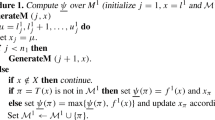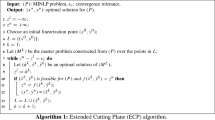Abstract
Mixed integer programming (MIP) formulations are typically tightened through the use of a separation algorithm and the addition of violated cuts. Using extended formulations involving new variables is a possible alternative, but this often results in prohibitively large MIPs where even the linear programming relaxations are hard or impossible to solve. In this paper, we demonstrate how, in certain cases, it is possible and interesting to define ``approximate'' extended formulations. In all the examples considered, our description involves a single control parameter K. Large values of K result in strong but large formulations. In particular, when K takes its maximum value, the approximate formulation is identical to the complete extended formulation. Through this approximation parameter, the user has control over the tradeoff between the strength and the size of the formulation.
Approximate extended formulations are proposed for a variety of lot-sizing problems and to the travelling salesman problem. We report computational results for several problems, including an industrial application and several small instances from the TSPLIB. The significant conclusion is that small values of the approximation parameter K are often sufficient to obtain excellent bounds.
Similar content being viewed by others
References
Balas E.: Disjunctive programming. Annals of Discrete Mathematics 5, 3–51 (1979)
Barany I., van Roy T.J., Wolsey L.A.: Uncapacitated lot-sizing: The convex hull of solutions. Math. Programming Stud. 22, 32–43 (1984)
Belvaux G., Wolsey L.A.: bc-prod: A specialized branch-and-cut system for lot-sizing problems. Management Science 46 (5), 724–738 (2000)
Eppen G.D., Martin R.K.: Solving multi-item lot-sizing problems using variable definition. Operations Research 35, 832–848 (1987)
Haus U-U., Köppe M., Weismantel R.: A primal all-integer algorithm based on irreducible solutions. Mathematical Programming 96, 205–246 (2003)
Jans R., Degraeve Z.: Improved lower bounds for the capacitated lot sizing problem with set up times. Operations Research Letters 32, 185–195 (2004)
Krarup J., Bilde O.: Plant location, set covering and economic lot sizes: an O(mn) algorithm for structured problems. In: L. Collatz et al. (eds.), Optimierung bei Graphentheoretischen und Ganzzahligen Probleme, Birkhauser Verlag, Basel pp 155–180 1977
Lovász L., Schrijver A.: Cones of matrices and set-functions and 0–1 optimization. SIAM Journal on Optimization 1, 166–190 (1991)
Miller A.J., Nemhauser G.L., Savelsbergh M.W.P.: Solving multi-item capacitated lot-sizing problems with setup times by branch-and-cut.CORE DP 2000/39, CORE, Université catholique de Louvain, 2000
Miller A.J., Wolsey L.A.: Tight MIP formulations for multi-item discrete lot-sizing problems. Operations Research 51, 557–565 (2003)
Miller C.E., Tucker A.W., Zemlin R.A.: Integer programming formulations and the traveling salesman problem. J. Assoc. Comput. Mach. 7, 326–329 (1960)
Padberg M., Sung T.-Y.: An analytical comparison of different formulations of the travelling salesman problem. Mathematical Programming 52, 315–357 (1991)
Pochet Y., Wolsey L.A. Polyhedra for lot-sizing with Wagner-Whitin costs. Mathematical Programming 67, 297–323 (1994)
Rardin R.L., Choe U.: Tighter relaxations of fixed charge network flow problems. report J-79-18, ISYE, Georgia Institute of Technolgy, 1979
Reinelt G.: TSPLIB: A library of sample instances for the TSP. http://www.iwr.uni-heidelberg.de/groups/ comopt/software/TSPLIB95/
Sherali H., Adams W.: A hierarchy of relaxations between the continuous and convex hull representations for zero-one programming problems. SIAM Journal of Discrete Mathematics 3, 411 – 430 (1990)
Stadtler H.: Reformulations of the shortest-route model for dynamic multi-item multi-level capacitated lot-sizing. OR Spektrum 19, 87–96 (1997)
Trigeiro W.W., Thomas L.J., McClain J.O.: Capacitated lot sizing with setup times. Management Science 35 (3), 353–366 (1989)
Van Vyve M.: Formulations for the single item lot-sizing problem with backlogging and constant capacity. To appear in Mathematical Programming
Van Vyve M.: A solution approach to production planning problems based on compact formulations for single-item lot-sizing models, Ph.D. thesis, Faculté des Sciences Appliquées, Université catholique de Louvain, 2003 http://www.core.ucl.ac.be/welcome/researchers/webpage%20Folder/academic. htm
Wolsey L.A.: Solving multi-item lot-sizing problems with an MIP solver using classification and reformulation. Management Science 48, 1587–1602 (2002)
Wolsey L.A.: Strong formulations for mixed integer programs: valid inequalities and extended formulations. Mathematical Programming B 97, 423–447 2003
Author information
Authors and Affiliations
Additional information
This text presents research results of the Belgian Program on Interuniversity Poles of Attraction initiated by the Belgian State, Prime Minister's Office, Science Policy Programming. The scientific responsibility is assumed by the authors.
Received: April 2004
Rights and permissions
About this article
Cite this article
Vyve, M., Wolsey, L. Approximate extended formulations. Math. Program. 105, 501–522 (2006). https://doi.org/10.1007/s10107-005-0663-7
Accepted:
Published:
Issue Date:
DOI: https://doi.org/10.1007/s10107-005-0663-7




